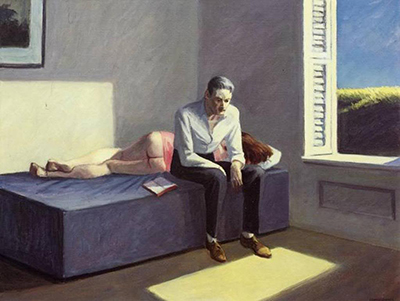Edward Hopper (1882 - 1967) was an American painter and printmaker, predominantly recognised for his oil painting and watercolours painted in a realist style.
Hopper is remembered for his quiet depictions of American everyday life, creating deeply evocative painting of lonely human figures in impersonal urban landscapes.
He has become deeply influential in American popular culture, particularly in cinema, for his filmic and emotionally resonant use of mise en scène. Contemporary writers, photographers, artists and filmmakers continue to be inspired by Hopper's paintings, which themselves attract large numbers of visitors when publicly exhibited.
Hopper trained as an etcher and worked for advertisement firms before becoming a professional artist. After several trips to Paris in his twenties, Hopper became enthralled with Impressionist painting and sought a career as a painter, predominantly in oil and watercolour.
Hopper's career took off in the 1920s, when his wife and manager—Josephine Nivison—established his reputation through a series of exhibitions and sales. Hopper often derived his subjects from American landscapes—predominantly modern urban landmarks such as gas stations, motels and restaurants—and their human inhabitants.
Frequently isolated, dwarfed, solitarily framed or caught in moments of quiet despair, Hopper has become known for focusing on the subtle and introspective moments of his subjects' loneliness. Excursion into Philosophy is no different, drawn as it is from a highly personal, yet surprisingly uncanny, space of a bedroom.
Painted with strong use of geometric shadow, it casts a solemn figure half in—and out—of light.
Excursion into Philosophy was painted in the latter period of Hopper's success, being completed in 1959. At the time, Hopper proclaimed this work his potential best and it sustains more mature themes of sexual and psychological tension than many of his pieces. In Excursion, a man sits on a bed, with a woman resting behind him—naked from the waist down—with her back towards him.
The disruption of the intimate moment by this physical lack of contact is heightened by the brooding face of the male subject and his open, discarded book. The book has since been identified as Plato. This is a puzzling choice which draws questions as to the man's introspection; is he ruminating over the philosophy he has read in the book or contemplating the meaning of his reality?




